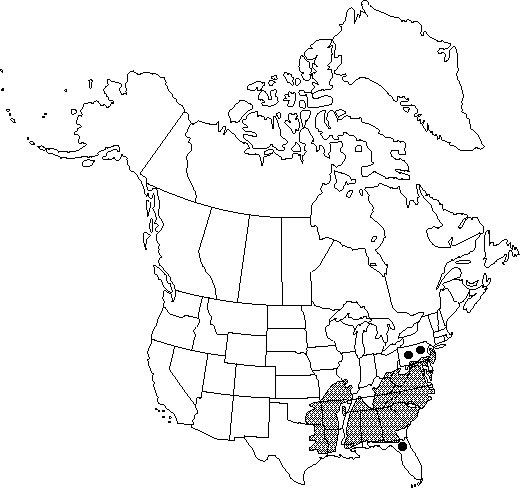Difference between revisions of "Pinus echinata"
Gard. Dict., ed. 8 Pinus no. 12. 1768.
FNA>Volume Importer |
imported>Volume Importer |
||
| (6 intermediate revisions by 2 users not shown) | |||
| Line 8: | Line 8: | ||
}} | }} | ||
|common_names=Shortleaf pine | |common_names=Shortleaf pine | ||
| + | |special_status={{Treatment/ID/Special_status | ||
| + | |code=E | ||
| + | |label=Endemic | ||
| + | }} | ||
|basionyms= | |basionyms= | ||
|synonyms= | |synonyms= | ||
| Line 23: | Line 27: | ||
|elevation=200–610m | |elevation=200–610m | ||
|distribution=Ala.;Ark.;Del.;Fla.;Ga.;Ill.;Ky.;La.;Md.;Miss.;Mo.;N.Y.;N.C.;Ohio;Okla.;Pa.;S.C.;Tenn.;Tex.;Va.;W.Va. | |distribution=Ala.;Ark.;Del.;Fla.;Ga.;Ill.;Ky.;La.;Md.;Miss.;Mo.;N.Y.;N.C.;Ohio;Okla.;Pa.;S.C.;Tenn.;Tex.;Va.;W.Va. | ||
| − | |discussion=<p>Although Pinus echinata is highly valued for timber and pulpwood, it is afflicted by root rot. It hybridizes with P. taeda, the pine most commonly associated with it.</p> | + | |discussion=<p>Although <i>Pinus echinata</i> is highly valued for timber and pulpwood, it is afflicted by root rot. It hybridizes with <i>P. taeda</i>, the pine most commonly associated with it.</p> |
|tables= | |tables= | ||
|references= | |references= | ||
| Line 32: | Line 36: | ||
-->{{#Taxon: | -->{{#Taxon: | ||
name=Pinus echinata | name=Pinus echinata | ||
| − | |||
|authority=Miller | |authority=Miller | ||
|rank=species | |rank=species | ||
| Line 45: | Line 48: | ||
|publication title=Gard. Dict., ed. 8 | |publication title=Gard. Dict., ed. 8 | ||
|publication year=1768 | |publication year=1768 | ||
| − | |special status= | + | |special status=Endemic |
| − | |source xml=https:// | + | |source xml=https://bitbucket.org/aafc-mbb/fna-data-curation/src/2e0870ddd59836b60bcf96646a41e87ea5a5943a/coarse_grained_fna_xml/V2/V2_681.xml |
|genus=Pinus | |genus=Pinus | ||
|species=Pinus echinata | |species=Pinus echinata | ||
Latest revision as of 20:24, 5 November 2020
Trees to 40m; trunk to 1.2m diam., straight; crown rounded to conic. Bark red-brown, scaly-plated, plates with evident resin pockets. Branches spreading-ascending; 2-year-old branchlets slender (ca. 5mm or less), greenish brown to red-brown, often glaucous, aging red-brown to gray, roughened and cracking below leafy portion. Buds ovoid to cylindric, red-brown, 0.5–0.7(–1)cm, resinous. Leaves 2(–3) per fascicle, spreading-ascending, persistent 3–5 years, (5–)7–11(–13)cm × ca. 1mm, straight, slightly twisted, gray- to yellow-green, all surfaces with fine stomatal lines, margins finely serrulate, apex abruptly acute; sheath 0.5–1(–1.5)cm, base persistent. Pollen cones cylindric, 15–20mm, yellow- to pale purple-green. Seed cones maturing in 2 years, semipersistent, solitary or clustered, spreading, symmetric, lanceoloid or narrowly ovoid before opening, ovoid-conic when open, 4–6(–7)cm, red-brown, aging gray, nearly sessile or on stalks to 1cm, scales lacking contrasting dark border on adaxial surfaces distally; umbo central, with elongate to short, stout, sharp prickle. Seeds ellipsoid; body ca. 6mm, gray to nearly black; wing 12–16mm. 2n =24.
Habitat: Uplands, dry forests
Elevation: 200–610m
Distribution

Ala., Ark., Del., Fla., Ga., Ill., Ky., La., Md., Miss., Mo., N.Y., N.C., Ohio, Okla., Pa., S.C., Tenn., Tex., Va., W.Va.
Discussion
Although Pinus echinata is highly valued for timber and pulpwood, it is afflicted by root rot. It hybridizes with P. taeda, the pine most commonly associated with it.
Selected References
None.